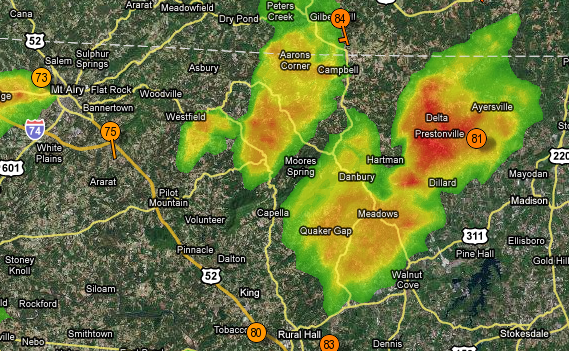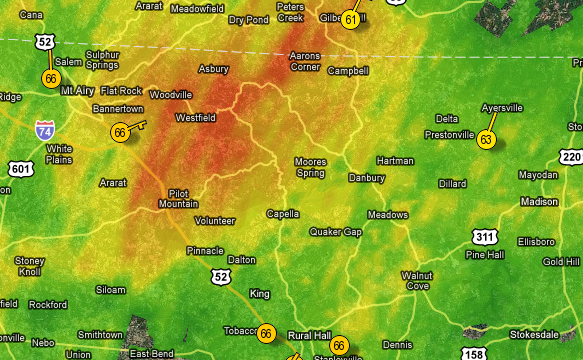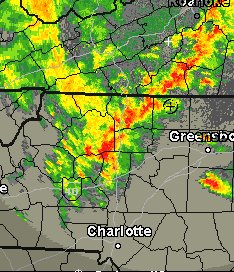Category: The land
At least the garden likes the hot weather
The drama of daisies and stuff
Daisies are so humble, but it’s flattering when they choose to grow in the weedpatch beside your driveway. Around here people mostly mow them down.
Every morning and every evening I go out for a walk to see how the grass and clover are coming along. It’s chiefly in the morning that you notice a difference. The clover got off to a very slow start, but some of it is starting to look like real clover. It’ll be a red-letter day when the first clover blooms. I sowed three kinds of clover — red, white, and Ladino clover. I believe this is red clover.
This bank was skinned back to the subsoil when the bulldozer made the driveway. I’m still weeks away from a vigorous stand of grass, but the peach fuzz is promising.
A baby tomato. It’s amazing how fast things grow in raised beds.
Rain today = tomatoes tomorrow

The reddest part of this squall missed me, but it left an eighth of an inch of rain yesterday.

Today we have real rainy-day rain, and it may go on for hours.
What I last lived in thunderstorm country (17 years ago), Internet radar didn’t exist. Now you can easily see when rain is approaching, and how much.
After they’ve had time to slurp up some of this rain, I’ll have some photos to show what the rain did for my baby tomatoes, peppers, peas, and beans.
First day lily
Cover crops: slow going
I have many spots where silt collected after rain, and the soil looked flat and barren. But there was grass seed under there, and eventually the grass breaks through with a vengeance.
It’s been a constant challenge to get cover crops going on more than an acre laid bare. The overall result is still far from photogenic. The soil was brutally disturbed three times — first for the taking out the pine trees, then again for removing the stumps, and then again for putting in the septic tank. I flung a variety of seeds, at different times, onto different conditions — fescue grass, rye grass, red clover, and white clover. In places I have pretty good cover, but the roots are still shallow, and rain is needed more often than it comes. In the really tough spots where the topsoil was removed — the front ditch and beside the driveway — I’ve watered regularly with a hose. Into the bare spots I poked beans and peas. Anything resembling lushness is weeks or months away, but stuff is growing.
Crops in straight and orderly rows, nicely segregated? Ha! Maybe someday. I poked seeds wherever I thought they might grow. Here we have corn, clover, fescue, and cucumber all in one place. Whether I harvest corn and cucumbers is not my main concern this year. I’ll take anything that has roots and holds the soil. The variety also makes for good experiments. I’ll learn a bit about what wants to grow where.
The beans and peas I planted all around are coming up very enthusiastically. With decent rain and a bit more nitrogen, who knows what might happen.
The cantaloupes are flourishing…
… and the tomatoes are doing well.
I’ve won the war for the front ditch. I now have strong fescue and young clover there, so even in a heavy downpour it’s no longer likely to erode.
Bonjour, bluebirds
Stormy weather

3.5 inches of rain bears down on Stokes County
A violent storm came through the area Thursday night. There were tornadoes 40 or so miles away. Here in Stokes we got high wind, a bit of hail, and 3.5 inches of rain. The rain did a fair amount of damage to the steep bank beside my new driveway where I’ve labored to get grass and clover to grow. The runoff made rivulets through the soil, exposing the roots of some of the tender young grass and clover and covering other areas with silt. Extremely depressing.
There was nothing to do but provide life support (in the form of gentle showers of water from the hose) to the young grass and clover to see if seedlings will re-root and stand up, and if the covered-over seedlings will push up through the silt.
On the areas where I have bare spots, my plan was to plant soybeans as a hardy cover. When I lived in the country back in the 1970s I had great luck with soybeans as cover. But the more I thought about it, the more I thought it best to plant the 25 or so varieties of beans and peas that I bought from Heirloom Seeds in a huge variety pack. I had no room for beans and peas in the raised bed or in the small areas where I added topsoil, so I planted things I really wanted — like canteloupes and little watermelons — and I had just set the bean and pea seeds aside. But, since beans and peas are hardy, and since even a poor germination rate and a poor crop is better than nothing, I thought why not give the beans a chance. With a pitchfork I made lots of little holes in the soil about an inch deep, and into each hole I dropped a bean or pea seed. I got about half done with this process before the rain started again this morning. As soon as I have a good break in the rain, I’ll go poke the rest of the seeds into the ground. The rain should give them a good start and a fighting chance of taking hold.
What's down the road from me
As I mentioned in a previous post, if you go about .4 mile up the road from me, you come to the paved public road. If you go down the road from me, you go across a tractor bridge and onto a little tractor road into the woods. Let’s walk down the road.
Baby clover in the morning dew. Where I exposed the soil for site preparation, I’ve worked hard to get ground cover growing, mainly fescue grass, rye, and red and white clover. This stuff is off to a good start. I’ll have more photos when it’s grown enough to be more photogenic.
Looking downstream in my woods
My little valley, where the branch comes through
Looking upstream in my woods
What pine trees do in the spring
When you’re in the woods, don’t forget to look down.
The woods are full of this in the spring, but I can’t for the life of me think what it’s called. Bonnie, what is this? Response: redbud
From this point on, we’re on neighbors’ land. The tractor bridge, and the lowest point on our little walk.
From the tractor bridge, looking downstream
On the next ridge, looking across a little valley. Do you espy anything familiar on the far hill?
In case you couldn’t find it, here’s the location of my little trailer seen from the opposite ridge.
Gardening with raised beds
My first raised bed. This one will soon have tomatoes in it.
I plan to garden using raised beds. If you do some Googling or ask someone who uses them, you’ll find they have a number of advantages. A couple of advantages that aren’t often mentioned: They make life easier for inexperienced gardeners like me. And they make it easier to work using only hand tools.
I don’t want to start collecting a bunch of powered machinery. It costs a lot of money, they have to be stored somewhere, they require maintenance, they make noise, and they use fuel. I want to try to do as much as I can using simple hand tools.
I’ll build a couple more of these raised beds during the next week or so. They’re not that much trouble to make, and they’re not that expensive. About $40 in posts, and about $70 for the commercial topsoil and composted cow manure to put in them.
